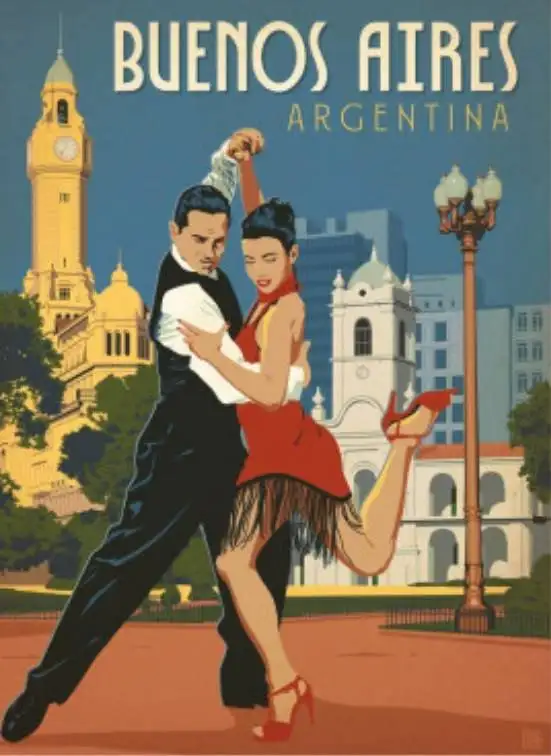Welcome to Buenos Aires, the birthplace of tango, where passion meets rhythm and every step tells a story. Whether you’re a seasoned dancer or a total beginner, chances are you’ve heard about tango and its deep connection to Argentine culture. But tango isn’t just a dance — it’s a journey through time, a social ritual, and a symbol of Buenos Aires itself. So, let’s take a deep dive into the history of tango, from its gritty origins to its global fame, and discover why this dance is so much more than just movement.
Tango Was Born in the Streets
Contents
Let’s rewind to the late 1800s in Buenos Aires. The city was booming with immigration, mostly from Europe, and neighborhoods like San Telmo and La Boca were filled with a mix of cultures, languages, and rhythms. In this melting pot of working-class immigrants, African descendants, and native Argentines, tango was born. It wasn’t born in fancy salons or theaters — tango started in the streets, bars, and crowded tenements, where people expressed their struggles, hopes, and desires through music and dance.
Back then, tango was a raw and improvised form of expression. The music mixed African candombe beats with European instruments like the violin, guitar, and eventually the bandoneón — an accordion-like instrument that became tango’s soul. The dance itself? Sensual, intense, and sometimes controversial. It was a dance of connection and improvisation, reflecting the energy of the city and the lives of the people who created it.
The Early Days: From the Margins to the Mainstream
In the early years, tango wasn’t exactly high society. It was seen as provocative and even a little scandalous. The upper classes of Buenos Aires weren’t too keen on tango at first, and it was mostly danced in lower-class areas. But you know what happens when something has real soul? It spreads.
By the early 1900s, tango started gaining popularity outside Argentina. Believe it or not, it was Paris that first embraced tango in a big way. Argentine travelers brought the dance to France, and it quickly became a hit in European salons. Suddenly, tango wasn’t just for the working class — it was chic, exotic, and totally in vogue. This international recognition made the Argentine elite take notice, and tango finally gained respect at home.
History of Tango, 1930’s: The golden age
Fast forward to the 1930s and 40s, and you’ll find yourself in the Golden Age of Tango. This was the moment when tango truly ruled the city. Orchestras filled dance halls, radio waves carried tango music across the country, and films featured tango stars in leading roles. Names like Carlos Gardel, Aníbal Troilo, and Osvaldo Pugliese became legends.
During this era, tango became more than just a dance — it was a cultural phenomenon. The lyrics of tango songs (known as “tangos”) spoke about love, loss, and the bittersweet beauty of life in Buenos Aires. People dressed up to go dancing at milongas (tango dance events), and the music echoed through every corner of the city.
A time of decline
But like all great stories, tango had its ups and downs. In the 1950s and 60s, political instability, economic struggles, and cultural shifts led to a decline in tango’s popularity. Young people turned to new genres like rock and roll, and tango was seen by some as old-fashioned. Many dance halls closed, and tango faded into the background.
However, even during this quieter time, the tango community never disappeared. Dedicated musicians, dancers, and fans kept the tradition alive, performing in smaller venues and passing on their knowledge to new generations.
Tango’s Big Comeback
The 1980s and 90s brought a tango revival that put the dance back in the global spotlight. Shows like Tango Argentino toured internationally, and tourists from all over the world began flocking to Buenos Aires to learn the real deal. Tango schools and milongas popped up all over the city, and once again, tango became a symbol of Argentine identity.
Today, tango is alive and thriving. It’s danced by people of all ages and backgrounds, from lifelong porteños to curious travelers. Whether you’re in a traditional milonga in Almagro or a modern dance hall in Palermo, you’ll feel the same passion and connection that have kept tango alive for over a century.
History of Tango: Tango today
Tango isn’t just for Argentines anymore — it’s truly a global dance. There are tango festivals, classes, and events in cities all over the world. But Buenos Aires remains the heart of it all. Here, you can experience the real tango culture: the music, the dance, the etiquette, and most importantly, the feeling.
Tango is also evolving. Contemporary dancers are blending traditional steps with modern styles, and musicians are experimenting with electronic tango (hello, Gotan Project!). But at its core, tango is still about connection, improvisation, and emotion.
Want to try It?
If you’re visiting Buenos Aires, trying tango is a must. You don’t need to be a pro — just be open to the experience. Many milongas offer beginner lessons, and the community is generally super welcoming. Even if you don’t dance, watching a live tango performance is a beautiful way to experience the culture.
Some popular places to get your tango fix:
- La Catedral: A quirky, boho venue with a laid-back vibe.
- Salon Canning: A classic milonga with experienced dancers and live music.
- El Querandí: A dinner-and-show spot with impressive tango performances.
History of Tango: More Than a Dance
Tango is a mirror of Buenos Aires — passionate, unpredictable, and full of life. The history of tango is a testament to the city’s resilience and creativity. From humble beginnings to international fame, tango has never lost its soul.
So the next time you hear the sound of a bandoneón, remember: you’re not just listening to music. You’re hearing the heartbeat of Buenos Aires.
And who knows? Maybe you’ll find yourself on the dance floor, feeling the rhythm, and becoming part of this incredible story.See you at the milonga? 🎶💃🌟









